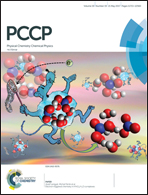Atomistic modeling to investigate the favored composition for metallic glass formation in the Ca–Mg–Ni ternary system
Abstract
A realistic interatomic potential was first constructed for the Ca–Mg–Ni system and then applied to Monte Carlo simulations to predict the favored composition for metallic glass formation in the ternary system. The simulations not only predict a hexagonal composition region, within which the Ca–Mg–Ni metallic glass formation is energetically favored, but also pinpoint an optimized sub-region within which the amorphization driving force, i.e. the energy difference between the solid solution and disordered phase, is larger than that outside. The simulations further reveal that the physical origin of glass formation is the solid solution collapsing when the solute atom exceeds the critical solid solubility. Further structural analysis indicates that the pentagonal bi-pyramids dominate in the optimized sub-region. The large atomic size difference between Ca, Mg and Ni extends the short-range landscape and facilitates the development of a hybridized packing model in the medium-range, and eventually enhancing the glass formation in the system. The predictions are well supported by the experimental observations reported so far, and could be of help for designing the ternary glass formation.



 Please wait while we load your content...
Please wait while we load your content...